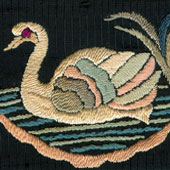Despite the commonly held boast that the Parsis in India were a more evolved better educated community as compared to their non-Parsi counterparts in the country of their adoption, the Parsis held many taboos and superstitions aloft in their everyday existence. A few those are relevant to this article on sari borders are mentioned below:
- Black saris and black borders were considered unlucky or inauspicious wear and meant only for funerals and memorial prayer services.
- White blouses were almost de rigeur for saris of any colour for everyday wear. This was for reasons of thrift (you did not have to make a blouse to match a particular sari as “white went with everything”) as well as because white was seen as auspicious and therefore a declaration of the purity of the wearer’s intentions.
- A knot at the end of the thread before you begun embroidery was considered inauspicious and therefore an absolute taboo. When you ended an embroidery sequence you turned the thread in and out and ended the sewing but never with a knot. Even today, when a sari is inspected before purchase, it is turned over to see if there are any knots in the embroidery work.
- Considerable significance is attached to the first time a young girl wears a sari. This is not just a declaration and societal acceptance of her coming of age but also an acknowledgement of her behaviour in adult society. Feasting often followed the party given in honour of this event. The “first sari” was almost always preserved as a special garment and remembered just as one would a wedding dress. Once this young woman goes through this celebration, she is expected to be treated as a lady and is expected to behave like one in adult society. Destroying the “first sari” or giving it away is seen as an act of sacrilege and an insult to collective memory. Thus the “first sari” is seen not just as another garment but as a repository of the community’scultural ties to the land of its adoption.



